Popular categories
Looking for a yarn?
The yarn cost is calculated from the pattern’s smallest size and the yarn’s cheapest product type. Looking for an even better price? You might find it on the DROPS Deals!
Celtic Comfort
Crocheted blanket in DROPS Air. The piece is worked in squares with cables and relief stitches.
DROPS Design: Pattern no ai-232
Yarn group C or A + A
-------------------------------------------------------
SIZE:
The piece measures approx.: Width = 96 cm = 37¾". Length = 122 cm = 48".
1 square measures approx. 24 x 24 cm = 9½" x 9½".
MATERIALS:
DROPS AIR from Garnstudio (belongs to yarn group C)
650 g color 03, pearl grey
CROCHET GAUGE:
13 double crochets in width and 10 rows in height (with pattern) = 10 x 10 cm = 4" x 4".
CROCHET HOOK:
DROPS CROCHET HOOK SIZE 5.5 MM = US I/9.
Hook size is only a guide. If you get too many stitches on 10 cm = 4", change to a larger hook size. If you get too few stitches on 10 cm = 4", change to a smaller hook size.
-------------------------------------------------------
Alternative Yarn – See how to change yarns here
Yarn Groups A to F – Use the same pattern and change the yarn here
Yarn usage using an alternative yarn – Use our yarn converter here
-------------------------------------------------------
The yarn cost is calculated from the pattern’s smallest size and the yarn’s cheapest product type. Looking for an even better price? You might find it on the DROPS Deals!
- English (US/in)
- Česky
- Dansk
- Deutsch
- Eesti keel
- English (UK/cm)
- Español
- Français
- Íslenska
- Italiano
- Magyar
- Nederlands
- Norsk
- Polski
- Português
- Suomi
- Svenska
- English (UK/cm), Bulgaria
- English (UK/cm), Croatia
- English (UK/cm), Greece
- English (UK/cm), Latvia
- English (UK/cm), Lithuania
- English (UK/cm), Romania
- English (UK/cm), Slovenia
- Česky, Slovakia
Pattern instructions
EXPLANATIONS FOR THE PATTERN:
-------------------------------------------------------
CHAIN STITCH:
If you work outermost on the hook the chain stitch will often be too tight; 1 chain stitch should be as long as 1 double crochet is wide.
CROCHET INFORMATION:
At the beginning of each row of double crochets work 1 chain stitch (in addition to the first double crochet).
At the beginning of each row of double crochets replace the first double crochet with 3 chain stitches.
PATTERN:
See diagrams A.1 to A.5.
SQUARES:
Work 4 of each of the following squares:
SQUARE 1: See diagram A.1.
SQUARE 2: See diagram A.2.
SQUARE 3: See diagram A.3.
SQUARE 4: See diagram A.4.
SQUARE 5: See diagram A.5.
QUADRUPLE-DOUBLE CROCHET:
Make 4 yarn overs, insert hook around stitch, pick up strand, make 1 yarn over and pull the strand through the first 2 loops on the hook *, repeat from *-* a total of 5 times = 1 stitch.
-------------------------------------------------------
START THE PIECE HERE:
-------------------------------------------------------
BLANKET – SHORT OVERVIEW OF THE PIECE:
The blanket is made up of 20 squares. Work 4 of each of the 5 different squares. Work all the squares first before working them together and finally working an edge along both short sides of the blanket.
CROCHET SQUARE:
Work 33 chain stitches (including 3 chain stitches to turn with) using hook size 5.5 mm = US I/9 and Air – read CHAIN STITCH. Turn and work 1 double crochet in the 4th chain stitch from the hook (= 2 double crochets) – read CROCHET INFORMATION, work 1 double crochet in each chain stitch to end of row = 31 double crochets.
Then work back and forth according to the diagram – read SQUARES and TRIPLE-TREBLE CROCHET. REMEMBER THE CROCHET GAUGE! When the diagram has been completed, cut and fasten the strand. The square measures approx. 24 x 24 cm = 9½" x 9½" .
ASSEMBLY:
Lay the squares out with the square numbers corresponding to the numbers in the illustration (4 squares in width and 5 in length). Make sure all squares are lying with the right side up and with the same crochet direction. The squares are worked together in length, then these lengths are worked together in width.
Work together as follows:
Lay 2 squares together, wrong side to wrong side. Work through both layers as follows: ** 1 double crochet in corner, * 3 chain stitches, skip forward approx. 1½-2 cm = ½"-¾", work 1 double crochet in next stitch *. Work from *-* up to and including the next corner and work 3 chain stitches (= transition to next 2 squares) **. Repeat from **-** along the whole length and finish with 1 double crochet in the last corner. Cut and fasten the strands. Work all the lengths together, then the lengths together in width in the same way.
EDGE:
Now work an edge along the one short side of the blanket as follows: Fasten the strand with 1 slip stitch in the first stitch in the corner and then work 3 chain stitches (= 1 double crochet), work 1 double crochet in each of the remaining double crochets along this side (= 4 squares of 31 stitches) = 124 double crochets. Cut and fasten the strand. Work a similar edge along the other short side.
Diagram
All measurements in charts are in cm.

|
= row already worked! Start at arrow |

|
= start here |

|
= single crochet in stitch |

|
= double crochet in stitch |

|
= 2 single crochets in same stitch |

|
= 2 SINGLE CROCHETS WORKED TOGETHER: * Insert hook in next stitch, pick up strand *, repeat from *-* one more time, make a yarn over and pull it through all 3 loops on hook (= 1 double crochet decreased) |

|
= RELIEF-DOUBLE-TREBLE CROCHET (only worked on row of double crochets): Work 1 double-treble crochet around the double crochet from the previous row of double crochets (do not work in loop, but around the double crochet itself). Start of line = row where this relief-double-treble crochet starts. The circle at the end of the relief-double-treble crochet = shows which double crochet from the previous double crochet row you are working around. |

|
= RELIEF-DOUBLE-TREBLE CROCHET (only worked on row of double crochets): Work 1 double-treble crochet around 1 double-treble crochet /triple-treble crochet from the previous row of double crochets (do not work in loops, but around the double-treble crochet /triple-treble crochet itself). Start of line = row where this relief-double-treble crochet starts. The dot at the end of the relief-doublecrochet = shows which double-treble crochet /triple-treble crochet from the previous row of double crochets you are working around. |

|
= RELIEF-TRIPLE-TREBLE CROCHET (only worked on row of double crochets): Work 1 triple-treble crochet around 1 double-treble crochet /triple-treble crochet from the previous double crochet row (do not work in loops, but around the double-treble crochet /triple-treble crochet itself. Start of line = row where this relief-triple-treble crochet starts. The square at the end of the relief-triple-treble crochet = shows which double-treble crochet /triple-treble crochet from the previous double crochet row you are working around. |

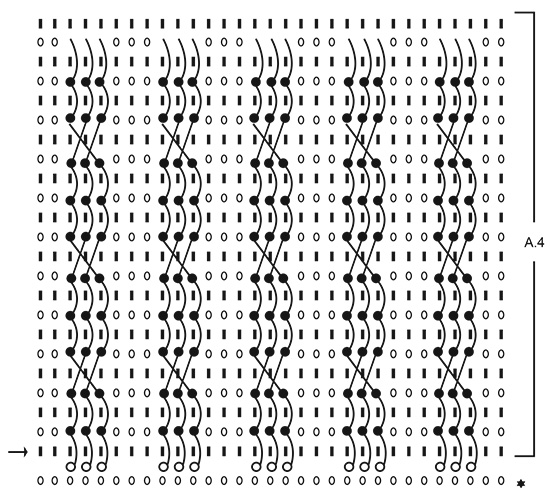
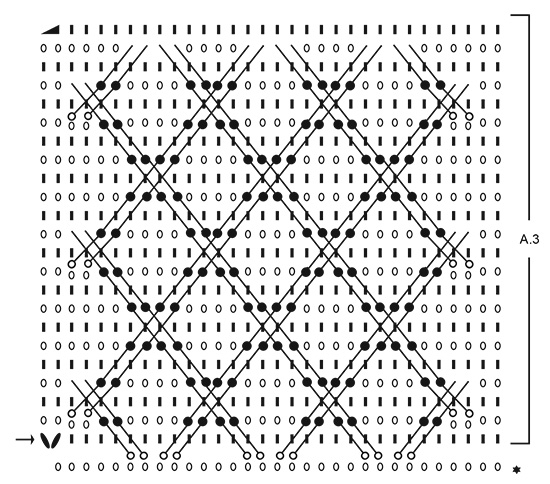

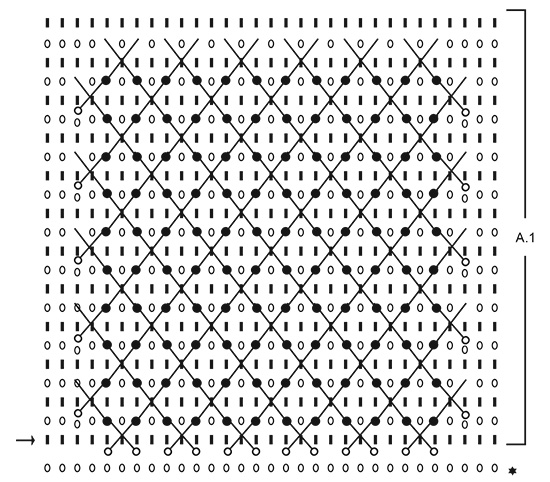
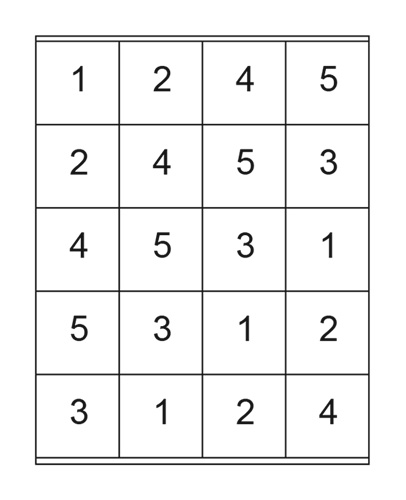
What can you do with our patterns? You can share DROPS patterns online, using the pattern original picture, materials, name and number. But you are NOT ALLOWED to reproduce the complete pattern digitally in any way. Yarn stores are welcome to use the DROPS pattern database to promote the sale of our assortment. You can print out our patterns, make as many copies as you’d like. The only thing we ask is that you don't make any changes / additions to the original printed document. And that the patterns according to the DROPS philosophy are given out to the consumers for free. Editorials that wish to publish our patterns in printed books or magazines can contact us for more information. The sale of garments based on DROPS patterns is permitted as long as they are sold as single items or per order. Further commercial use of the patterns is not permitted. It has to be clearly stated that the garment is made based on a design from DROPS DESIGN. The use of clothing labels of which DROPS DESIGN forms part is conditioned by the inclusion of the following text: “A DROPS DESIGN made by …..”. The use of DROPS photos for marketing purposes/sales is only permitted in connection with the use/sale of DROPS products. The photos may not be cut or edited and the logo should be clearly visible.
We reserve the right to withdraw the permission for use of our patterns at any time, notwithstanding the reason.
Each of our patterns has specific tutorial videos to help you.
These step-by-step tutorials might also help you:
Why is the knitting/crochet tension so important?
Knitting tension is what determines the final measurements of your work, and is usually measured per 10 x 10 cm. It is provided like so: number of stitches in width x number of rows in height - eg: 19 stitches x 26 rows = 10 x 10 cm.
The knitting tension is very individual; some people knit/crochet loosely while others work tightly. You adjust the knitting tension with the needle size, which is why the suggested needle size only serve as a guide! You need to adjust this (up or down) to ensure that YOUR knitting tension matches the knitting tension provided in the pattern. If you work with a different knitting tension than provided you will have a different yarn consumption, and your work will have different measurements than what the pattern suggests.
The knitting tension also determines which yarns can replace each other. As long as you achieve the same knitting tension you can replace one yarn with another.
See DROPS lesson: How to measure your tension/gauge
See DROPS video: How to make a gauge tension swatch
How do I know how many balls of yarn I need?
The required amount of yarn is provided in grams, eg: 450 g. To calculate how many balls you’ll need you first need to know how many grams are in 1 ball (25g, 50g or 100g). This information is available if you click on the individual yarn quality on our pages. Divide the amount required with the amount of each ball. For example, if each ball is 50g (the most common amount), the calculation will be as follows: 450 / 50 = 9 balls.
Can I use a different yarn than what the pattern suggests?
The important thing when changing from one yarn to another is that the knitting/crochet tension remains the same. This is so that the measurements of the finished piece will be the same as on the sketch provided. It is easier to achieve the same knitting tension using yarns from the same yarn group. It is also possible to work with multiple strands of a thinner yarn to achieve the knitting tension of a thicker one. Please try our yarn converter. We recommend you to always work a test swatch.
Please NOTE: when changing yarn the garment might have a different look and feel to the garment in the photo, due to individual properties and qualities of each yarn.
See DROPS lesson: Can I use a different yarn than the one mentioned in the pattern?
What are the yarn groups?
All our yarns are categorised into yarn groups (from A to F) according to thickness and knitting tension – group A contains the thinnest yarns and group F the thickest. This makes it easier for you to find alternative yarns to our patterns, should you wish to switch yarn. All yarns within the same group have a similar knitting tension and can easily replace each other. However, different yarn qualities have different structures and properties which will give the finished work a unique look and feel.
How do I use the yarn converter?
At the top of all our patterns you’ll find a link to our yarn converter, which is a helpful tool should you wish to use a different yarn than suggested. By filling in the yarn quality you wish to replace, the amount (in your size) and number of strands, the converter will present good alternative yarns with the same knitting tension. Additionally it will tell you how much you’ll require in the new qualities and whether you’ll need to work with multiple strands. Most skeins are 50g (some are 25g or 100g).
If the pattern is worked with multiple colours, every colour will have to be converted separately. Similarly, if the pattern is worked with several strands of different yarns (for example 1 strand Alpaca and 1 strand Kid-Silk) you will have to find alternatives for each, individually.
Why do you show discontinued yarns in the patterns?
Since different yarns have different qualities and textures we have chosen to keep the original yarn in our patterns. However, you can easily find options among our available qualities by using our yarn converter, or simply pick a yarn from the same yarn group.
It is possible that some retailers still have discontinued yarns in stock, or that someone has a few skeins at home that they would like to find patterns for.
The yarn converter will provide both alternative yarn as well as required amount in the new quality.
What size should I knit?
If you think it's hard to decide what size to make, it can be a good idea to measure a garment you own already and like the size of. Then you can pick the size by comparing those measures with the ones available in the pattern's size chart.
You'll find the size chart at the bottom of the pattern.
See DROPS lesson: How to read size chart
Why do I get the wrong knitting tension with the suggested needle size?
The needle size provided in the pattern serves only as a guide, the important thing is to follow the knitting tension. And since knitting tension is very individual, you will have to adjust the needle size to ensure that YOUR tension is the same as in the pattern – maybe you’ll have to adjust 1, or even 2 needle sizes, up or down to achieve the correct tension. For this, we recommend that you work test swatches.
Should you work with a different knitting tension than the one provided, the measurements of the finished garment might deviate from the measurement sketch.
See DROPS lesson: How to measure your tension/gauge
See DROPS video: How to make a gauge tension swatch
Why is the pattern worked top-down?
Working a garment top-down provides more flexibility and room for personal adjustment. For example it is easier to try the garment on while working, as well as making adjustments to length of yoke and shoulder caps.
The instructions are carefully explaining every step, in the correct order. Diagrams are adjusted to the knitting direction and are worked as usual.
How do I work according to a knitting diagram?
The diagram depicts all rows/rounds, and every stitch seen from the right side. It is read from bottom to top, from right to left. 1 square = 1 stitch.
When working back and forth, every other row is worked from the right side and every other row is worked from the wrong side. When working from the wrong side, the diagram will have to be worked reversed: from left to right, knit stitches are purled, purl stitches are knit etc.
When working in the round every round is worked from the right side and the diagram are worked from right to left on all rounds.
See DROPS lesson: How to read knitting diagrams
How do I work according to a crochet diagram?
The diagram depicts all rows/rounds, and every stitch seen from the right side. It is worked from bottom to top, from right to left.
When working back and forth every other row is worked from the right side: from right to left and every other row is worked from the wrong side: from left to right.
When working in the round, every row in the diagram are worked from the right side, from right to left.
When working a circular diagram you start in the middle and work your way outwards, counter clockwise, row by row.
The rows usually start with a given number of chain stitches (equivalent to the height of the following stitch), this will either be depicted in the diagram or explained in the pattern.
See DROPS lesson: How to read crochet diagrams
How do I work several diagrams simultaneously on the same row/round?
Instructions for working several diagrams after each other on the same row/round, will often be written like so: “work A.1, A.2, A.3 a total of 0-0-2-3-4 times". This means you work A.1 once, then A.2 is worked once, and A.3 is repeated (in width) the number of times provided for your size – in this case like so: S = 0 times, M = 0 times, L=2 times, XL= 3 times and XXL = 4 times.
The diagrams are worked as usual: begin with the first row in A.1, then work the first row in A.2 etc.
See DROPS lesson: How to read knitting diagrams
See DROPS lesson: How to read crochet diagrams
Why are the sleeves shorter in larger sizes?
The total width of the garment (from wrist-to-wrist) will be larger in the larger sizes, despite the actual sleeves being shorter. The larger sizes have longer sleeve caps and wider shoulders, so there will be a good fit in all sizes.
Where on the garment is the length measured?
The measurement sketch/schematic drawing provides information regarding the full length of the garment. If it’s a jumper or a jacket the length is measured from the highest point on the shoulder (usually closest to the neckline), and straight down to the bottom of the garment. It is NOT measured from the tip of shoulder. Similarly, the length of yoke is measured from the highest point on the shoulder and down to where yoke is split into body and sleeves.
See DROPS lesson: How to read a schematic drawing
What is a repeat?
Diagrams are often repeated on the round or in height. 1 repeat is the diagram the way it appears in the pattern. If it says to work 5 repeats of A.1 in the round, then you work A.1 a total of 5 times after/next to each other in the round. If it says to work 2 repeats of A.1 vertically/in height you work the entire diagram once, then begin again at the start and work the entire diagram one more time.
Why does the piece start with more chain stitches than it’s worked with?
Chain stitches are slightly narrower than other stitches and to avoid working the cast-on edge too tight, we simply chain more stitches to begin with. The stitch count will be adjusted on the following row to fit the pattern and measurement sketch.
Why increase before the rib edge when the piece is worked top-down?
The rib edge is more elastic and will contract slightly compared to, for example, stocking stitch. By increasing before the rib edge, you avoid a visible difference in width between the rib edge and the rest of the body.
Why increase in the cast-off edge?
It’s very easy to cast off too tightly, and by making yarn overs while casting off (and simultaneously casting these off) you avoid a too tight cast off edge.
See DROPS video: How to bind off with yarn overs (yo)
How do I increase/decrease on every 3rd and 4th row/round alternately?
To achieve an even increase (or decrease) you can increase on, for example: every 3rd and 4th row alternately, like so: work 2 rows and increase on the 3rd row, work 3 rows and increase on the 4th. Repeat this until the increase is complete.
See DROPS lesson: Increase or decrease 1 st on every 3rd and 4th row alternately
How can I work a jacket in the round instead of back and forth?
Should you prefer to work in the round instead of back and forth, you may of course adjust the pattern. You’ll need to add steeks mid-front (usually 5 stitches), and follow the instructions. When you would normally turn and work from the wrong side, simply work across the steek and continue in the round. At the end you’ll cut the piece open, pick up stitches to work bands, and cover the cut edges.
See DROPS video: How to knit steeks and cut open
Can I work a jumper back and forth instead of in the round?
Should you prefer to work back and forth instead of in the round, you may of course adjust the pattern so you work the pieces separately and then assemble them at the end. Divide the stitches for the body in 2, add 1 edge stitch in each side (for sewing) and work the front and back pieces separately.
See DROPS lesson: Can I adapt a pattern for circular needles into straight needles?
Why is the pattern slightly different than what I see in the photo?
Pattern repeats can vary slightly in the different sizes, in order to get the correct proportions. If you’re not working the exact same size as the garment in the photo, yours might deviate slightly. This has been carefully developed and adjusted so that the complete impression of the garment is the same in all sizes.
Make sure to follow instructions and diagrams for your size!
How do I make a women’s size garment into a men’s size one?
If you have found a pattern you like which is available in women’s size it’s not very difficult to convert it to men’s size. The biggest difference will be the length of sleeves and body. Start working on the women size that you think would fit across the chest. The additional length will be worked right before you cast off for the armhole/sleeve cap. If the pattern is worked top-down you can add the length right after the armhole or before the first decrease on sleeve.
Regarding additional yarn amount, this will depend on how much length you add, but it is better with a skein too many than too few.
How do I prevent a hairy garment from shedding?
All yarns will have excess fibres (from production) that might come off as lint or shedding. Brushed yarns (ie hairier yarns) have more of these loose, excess fibres, causing more shedding.
Shedding also depends on what is worn under or over the garment, and whether this pulls at the yarn fibres. It’s therefore not possible to guarantee that there will be no shedding
Below are some tips on how to get the best result when working with hairier yarns:
1. When the garment is finished (before you wash it) shake it vigorously so the looser hairs come off. NOTE: do NOT use a lint roller, brush or any method that pulls at the yarn.
2. Place the garment in a plastic bag and put it in your freezer - the temperature will cause the fibres to become less attached to each other, and excess fibres will come off easier.
3. Leave in the freezer for a few hours before taking it out and shaking it again.
4. Wash the garment according to the instructions on the yarn label.
Why does my garment pill?
Pilling is a natural process that happens to even the most exclusive of fibers. It's a natural sign of wear and tear that is hard to avoid, and that is most visible in high friction areas of your garment like a sweater's arms and cuffs.
You can make your garment look as new by removing the pilling, using a fabric comb or a pill/lint remover.
In the meantime, you can read the questions and answers that others have left to this pattern or join the DROPS Workshop on Facebook to get help from fellow knitters/crocheters!
You might also like...
Celtic Comfort |
||||||||||||||||||||||||||||
 |
 |
|||||||||||||||||||||||||||
Crocheted blanket in DROPS Air. The piece is worked in squares with cables and relief stitches.
DROPS 203-1 |
||||||||||||||||||||||||||||
|
------------------------------------------------------- EXPLANATIONS FOR THE PATTERN: ------------------------------------------------------- CHAIN STITCH: If you work outermost on the hook the chain stitch will often be too tight; 1 chain stitch should be as long as 1 double crochet is wide. CROCHET INFORMATION: At the beginning of each row of double crochets work 1 chain stitch (in addition to the first double crochet). At the beginning of each row of double crochets replace the first double crochet with 3 chain stitches. PATTERN: See diagrams A.1 to A.5. SQUARES: Work 4 of each of the following squares: SQUARE 1: See diagram A.1. SQUARE 2: See diagram A.2. SQUARE 3: See diagram A.3. SQUARE 4: See diagram A.4. SQUARE 5: See diagram A.5. QUADRUPLE-DOUBLE CROCHET: Make 4 yarn overs, insert hook around stitch, pick up strand, make 1 yarn over and pull the strand through the first 2 loops on the hook *, repeat from *-* a total of 5 times = 1 stitch. ------------------------------------------------------- START THE PIECE HERE: ------------------------------------------------------- BLANKET – SHORT OVERVIEW OF THE PIECE: The blanket is made up of 20 squares. Work 4 of each of the 5 different squares. Work all the squares first before working them together and finally working an edge along both short sides of the blanket. CROCHET SQUARE: Work 33 chain stitches (including 3 chain stitches to turn with) using hook size 5.5 mm = US I/9 and Air – read CHAIN STITCH. Turn and work 1 double crochet in the 4th chain stitch from the hook (= 2 double crochets) – read CROCHET INFORMATION, work 1 double crochet in each chain stitch to end of row = 31 double crochets. Then work back and forth according to the diagram – read SQUARES and TRIPLE-TREBLE CROCHET. REMEMBER THE CROCHET GAUGE! When the diagram has been completed, cut and fasten the strand. The square measures approx. 24 x 24 cm = 9½" x 9½" . ASSEMBLY: Lay the squares out with the square numbers corresponding to the numbers in the illustration (4 squares in width and 5 in length). Make sure all squares are lying with the right side up and with the same crochet direction. The squares are worked together in length, then these lengths are worked together in width. Work together as follows: Lay 2 squares together, wrong side to wrong side. Work through both layers as follows: ** 1 double crochet in corner, * 3 chain stitches, skip forward approx. 1½-2 cm = ½"-¾", work 1 double crochet in next stitch *. Work from *-* up to and including the next corner and work 3 chain stitches (= transition to next 2 squares) **. Repeat from **-** along the whole length and finish with 1 double crochet in the last corner. Cut and fasten the strands. Work all the lengths together, then the lengths together in width in the same way. EDGE: Now work an edge along the one short side of the blanket as follows: Fasten the strand with 1 slip stitch in the first stitch in the corner and then work 3 chain stitches (= 1 double crochet), work 1 double crochet in each of the remaining double crochets along this side (= 4 squares of 31 stitches) = 124 double crochets. Cut and fasten the strand. Work a similar edge along the other short side. |
||||||||||||||||||||||||||||
Diagram explanations |
||||||||||||||||||||||||||||
|
||||||||||||||||||||||||||||

|
||||||||||||||||||||||||||||

|
||||||||||||||||||||||||||||

|
||||||||||||||||||||||||||||

|
||||||||||||||||||||||||||||

|
||||||||||||||||||||||||||||

|
||||||||||||||||||||||||||||
|
Have you made this or any other of our designs? Tag your pictures in social media with #dropsdesign so we can see them! Do you need help with this pattern?You'll find tutorial videos, a Comments/Questions area and more by visiting the pattern on garnstudio.com. © 1982-2024 DROPS Design A/S. We reserve all rights. This document, including all its sub-sections, has copyrights. Read more about what you can do with our patterns at the bottom of each pattern on our site. |
||||||||||||||||||||||||||||
With over 40 years in knitting and crochet design, DROPS Design offers one of the most extensive collections of free patterns on the internet - translated to 17 languages. As of today we count 304 catalogs and 11422 patterns - 11417 of which are translated into English (US/in).
We work hard to bring you the best knitting and crochet have to offer, inspiration and advice as well as great quality yarns at incredible prices! Would you like to use our patterns for other than personal use? You can read what you are allowed to do in the Copyright text at the bottom of all our patterns. Happy crafting!












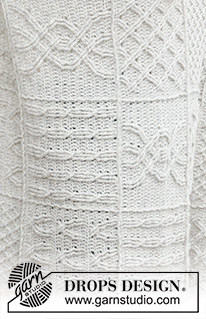






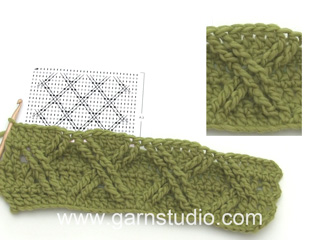





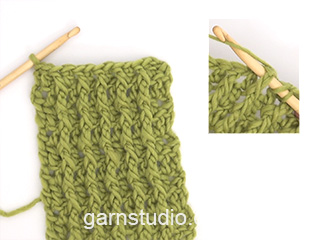


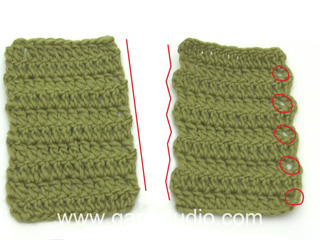





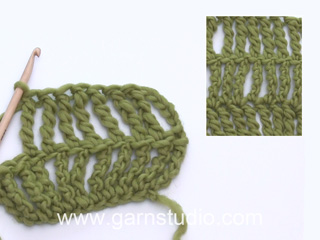


















Comments / Questions (49)
Is it possible to get a written pattern?
21.02.2022 - 03:05DROPS Design answered:
Hi Jerrian, We do not produce paper patterns anymore, to save on paper use and decrease our environmental footprint. You can print out the pattern yourself by using the button below and to the right of the photos. Happy crafting!
21.02.2022 - 07:07I'm new to reading the diagrams. I don't see an explanation for the diamond symbol in the A5 block. Can you please explain it to me?
21.02.2022 - 02:42DROPS Design answered:
Dear Jerrian, do you mean the last symbol in the diagram key? That's a line finishing with a black square - this video shows how to crochet A.5 and might then help you. Happy crocheting!
21.02.2022 - 10:20Bonjour Pourquoi ne faire une bordure uniquement en haut et bas et non pas sur les côtés. Merci de votre réponse. Cordialement.
06.02.2022 - 21:10DROPS Design answered:
Bonjour Françoise, c'est un choix de la styliste, vous pouvez naturellement choisir de procéder autrement. Bon crochet!
07.02.2022 - 10:36Bonjour Je n'ai jamais fais de torsades au crochet et ne comprends pas comment les faire. Je commence par le diagramme A1 et voudrais savoir comment démarrer le 1er rg et faire les 6 torsades et de même pour le 2ème rg de torsades pour que celles-ci soient dans leur prolongement. Merci de votre aide. Cordialement
26.01.2022 - 20:42DROPS Design answered:
Bonjour Françoise, nous avons une vidéo pour chacun des carrés, retrouvez celle du diagramme A.1 ici, rappelez-vous de bien suivre le diagramme en même temps. Vous devriez ainsi comprendre comment procéder; n'hésitez pas à ralentir le débit si besoin (en cliquant sur la roue crantée, en cours de lecture). Bon crochet!
27.01.2022 - 08:43Salve! Nel diagramma il simbolo della quinta riga indica " 2 maglie base nella stessa maglia". È un errore di trascrizione per cui si intendono due maglie basse nella stessa maglia? Perché in caso contrario non so cosa vuol dire e nel video tutorial non viene fatto vedere il secondo giro. Grazie.
21.11.2021 - 17:23DROPS Design answered:
Buonasera Ester, abbiamo corretto il testo, erano maglie basse. Buon lavoro!
21.11.2021 - 21:51Hei, takk for en flott oppskrift. Jeg synes det er litt vanskelig å forstå hvordan lappene skal monteres sammen. Kunne dere lagt ut bilder (steg for steg) eller video i tillegg til forklaringen?
29.12.2020 - 10:28DROPS Design answered:
Hej Stine, Se her hvordan du kan gøre: Montering af tæppe eller her finder du endnu flere måder at gøre det på: Montering - hækle sammen
07.01.2021 - 13:54Hallo, Is er ook een deken als deze maar dsn om te breien? Mijn haakskils zijn niet zo goed.
31.07.2020 - 07:44DROPS Design answered:
Dag Evelone,
Helaas is er van deze alleen een versie om te haken. Misschien vindt je een geschikt patroon tussen de gebreide dekens met kabels.
02.08.2020 - 19:04Modello bellissimo, lana stupenda. Ne ho finita una di 35 quadrati. Ho iniziato la seconda di un altro colore. Grazie
23.07.2020 - 21:17A może Drops Muskat? Już sama nie wiem. Dziewiarki proponowały jeszcze: Drops Muskat Drops Paris Drops You #8 Scheepjes Cahlista Nie widziałam tych włóczek, dlatego ciężko mi wybrać. To ma być narzuta na kanapę, odporna na częste siedzenie na niej. Drops Muskat to dobra bawełna merceryzowana, ale cieńsza.
13.07.2020 - 20:26DROPS Design answered:
Witaj Kasiu, to jest w końcu koc. Nie musisz się tak bardzo trzymać wymiarów. Jak weźmiesz Muskat, weź też mniejsze szydełko. Jak koc będzie za mały, możesz jeszcze dorobić kwadratów. Miłej pracy!
14.07.2020 - 10:47Czy Drops Cotton Light będzie dobra do tego wzoru? Ile motków potrzeba? Wzór jest piękny. Czy słupki nakładane to słupki reliefowe od przodu (for example: front post treble crochet)?
12.07.2020 - 11:05DROPS Design answered:
Witaj Kasiu, Cooton Light jest z Grupy B, a nie C. Z włóczek w promocji lepsza będzie DROPS Paris (1 nitka) 1300g lub DROPS Bomull-Lin (1 nitka) 1148g. Co do słupków nakładanych to są inaczej słupki reliefowe. Zobacz filmy video do tego wzoru, w których dokładnie pokazujemy jak je wykonać . Powodzenia!
13.07.2020 - 10:48